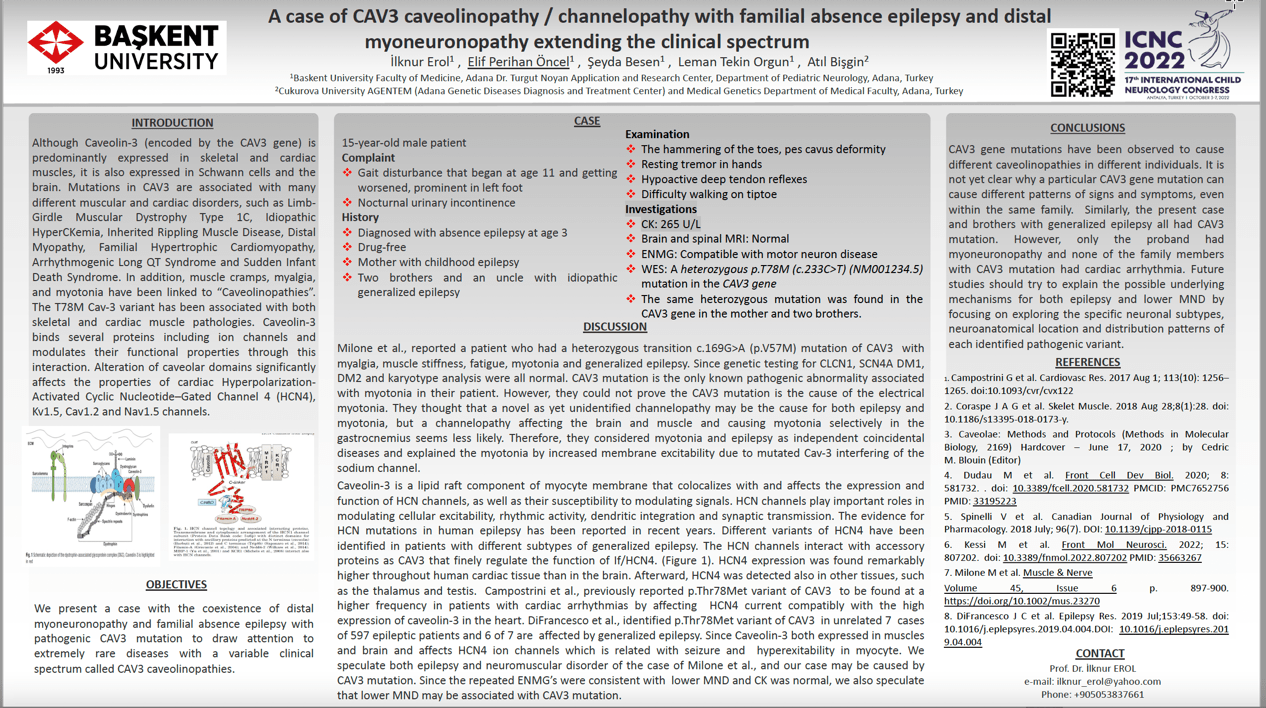A case of CAV3 caveolinopathy / channelopathy with familial absence epilepsy and distal myoneuronopathy extending the clinical spectrum
İlknur Erol, Elif Perihan Öncel, Şeyda Beşen, Leman Tekin Orgun, Atıl Bişgin
Objectives Heterozygous mutations in genes encoding T-type,low-voltage-activated calcium channels,called Cav3 channels,have been associated with a variety of neurodevelopmental,neurological and psychiatric diseases. Methods In this article, we present a case with both distal myoneuronopathy and familial absence epilepsy associated with CAV3 mutation to draw the attention to extremely rare diseases with a variable clinical spectrum called Cav3 caveolinopathies or Cav3 channelopathies. Results 15-year-old male patient,who was followed up with the diagnosis of absence epilepsy since the age of three,had two of brothers and an uncle with idiopathic generalized epilepsy,presented with gait disturbance. Her mother had a history of epilepsy that was treated in childhood.Neurological examination revealed hammering of the toes,pes cavus deformity,resting tremor in hands and hypoactive deep tendon reflexes.Both brain and spinal MRI were normal.Electroneuromyography was compatible with motor neuron disease.Whole exome analysis was performed to determine etiology of distal neuropathy and neuronopathy.A heterozygous p.T78M (c.233C>T) (NM001234.5) mutation was detected in the CAV3 gene. The same heterozygous mutation was found in the CAV3 gene in the mother and two brothers. Conclusions With the widespread use of advanced genetic studies,the relationship between the molecular and functional consequences of mutations and diseases has been revealed more clearly.In this article, it is aimed to discuss the genotype-phenotype relationship in a patient with both absence epilepsy and distal myoneuronopathy and to expand the phenotypic spectrum of Cav3 caveolinopathies with the finding of distal neuronopathy.
Keywords: CAV3, caveolinopathy, channelopathy, absence, epilepsy, myoneuronopathy
İlknur Erol
Baskent University Faculty of Medicine,
Adana Dr. Turgut Noyan Application and Research Center
Turkey
Elif Perihan Öncel
Baskent University Faculty of Medicine,
Adana Dr. Turgut Noyan Application and Research Center
Turkey
Şeyda Beşen
Baskent University Faculty of Medicine,
Adana Dr. Turgut Noyan Application and Research Center
Turkey
Leman Tekin Orgun
Baskent University Faculty of Medicine,
Adana Dr. Turgut Noyan Application and Research Center
Turkey
Atıl Bişgin
Cukurova University AGENTEM
Adana Genetic Diseases Diagnosis and Treatment Center) and Medical Genetics Department of Medical Faculty
Turkey

Baskent University Faculty of Medicine,
Adana Dr. Turgut Noyan Application and Research Center
Turkey